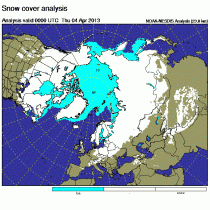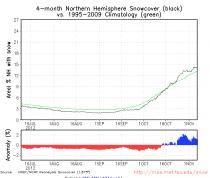By P Gosselin on 8. November 2012
As snow falls over New Jersey and other parts of the mid-Atlantic states, the Northeast USA is not the only region being visited early by old man winter.
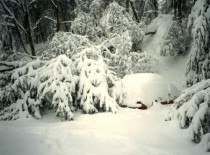
Winter visits early. (Illustration photo, source: NOAA).
Heavy snows have also hit China, hitting Peking with full force, according to German online Bild daily, which writes:
Snow Alarm in China! The capital Peking has been paralyzed by a winterstorm. [...] The situation is worse in the countryside regions of North China. In the Yanqing region 47 cm of snow fell in just a few hours, entire villages have been cut off, thousands are without power and heat. [...] A group of Japanese tourists got caught in drifting snow while on the Great Wall; three women froze to death.’
Winter also paid an early visit last weekend in England, reports the Daily Mail, with snow falling in the South and West Country, including in Somerset, Dorset, Wiltshire and Devon. The Mail writes that “the snowfall was England’s fifth in nine days amid an early winter”. and that “temperatures plunged to -5.6C last night at Aboyne, Aberdeenshire, with -4.3C Redesdale Camp, Northumberland, and -0.9C at Brize. The Weather Service says temperatures are up to 5C below normal.
Snow was also reported in Gloucestershire and Dorset, with “up to six inches in Somerset in Bath, Frome, Midsomer Norton and the Mendip Hills” The Mail quotes. Charlie Powell, forecaster at the Met Office:
It has been incredibly cold recently and the snow was caused by an area of low pressure coming in from the North West.”
And adds:
More snow is due on higher ground in the North by Friday, with mainly below-average temperatures expected for the whole of November.”
Britain’s early winter is being enhanced by a mid-Atlantic high pressure preventing mild south-westerly winds from reaching Britain, and is pumping in Arctic air from Greenland.
So much for snow being a thing of the past at the middle latitudes. Indeed winter is making early appearances not only locally, but globally. Odd signs of warming, wouldn’t you say?
Gerri Willis
Another Green Company Goes Bust

Just in case any of you out there continue to harbor the belief government can do things better than the private sector: witness Satcon Technology Corp.
The Massachusetts- based solar energy company filed for Chapter 11 bankruptcy on Wednesday, which makes it the second taxpayer backed company to go toes up this week. Electric car battery company, A123 filed Tuesday.
Another week, and another hundred million or so of taxpayer money thrown out the window. Even the companies that continue to operate like LG Chem, a lithium-ion plant in Holland, Michigan are struggling. The plant, which was built with taxpayer dollars, is supposed to be making batteries for the Chevy Volt.
However, a local TV station reported employees at the company have so little work to do, that they spend hours playing cards and board games, reading magazines and watching movies. Some can’t take the boredom and are quitting! In other words, even as a government make-work project, LG Chem is failing!
Here’s President Obama at that plant just over two years ago.
“These plants will put thousands of people to work. This includes folks who were working at a couple of facilities being built in Michigan by another battery technology company called A123. This is a symbol of where Michigan is going, this is a symbol of where Holland is going, this is a symbol of where America is going.”
A symbol of where America is going!
By the way, LG Chem is a Korean company that received a $151 million grant from U.S. taxpayers.
Anyway, back to Satcon. The good news is that the company only used $228,000 worth of taxpayer dollars, even though it was approved for $3 million under Obama’s Department of Energy.
Though it’s hard to see why.
Satcon has struggled financially for years. Its power conversion devices and other products were in steady demand in 2011, but the company’s managers couldn’t translate that into profitability.
The company posted losses each year from 2005 to 2011, as well as the first six months of 2012.
But look, it’s not just Satcon and A123.
According to the Heritage Foundation, 34 of the green energy companies that have gotten some sort of government assistance are faltering, going bankrupt, laying people off, or planning a bankruptcy.
Take a look at the list.
Heritage estimates that of the $90 billion in green energy loans, grants, and tax credits, 10% have gone to companies that are either bankrupt or circling the drain.
Even one, in my opinion is too many. This is precisely why the government shouldn’t be in the business of picking winners and losers; or as Mitt Romney put it:
“You don’t pick winners and losers, you pick losers.”
Read more.
By Doyle Rice, USATODAY
The number of natural disasters per year has been rising dramatically on all continents since 1980, but the trend is steepest for North America where countries have been battered by hurricanes, tornadoes, floods, searing heat and drought, a new report says.
The study being released today by Munich Re, the world’s largest reinsurance firm, sees climate change driving the increase and predicts those influences will continue in years ahead, though a number of experts question that conclusion.
Whatever the causes, the report shows that if you thought the weather has been getting worse, you’re right. No Doyle< they are not
The report finds that weather disasters in North America are among the worst and most volatile in the world: “North America is the continent with the largest increases in disasters,” says Munich Re’s Peter Roder.
The report focuses on weather disasters since 1980 in the USA, Canada, Puerto Rico and the U.S. Virgin Islands.
Roder says this report represents the first finding of a climate change “footprint” in the data from natural catastrophes.
Some of the report’s findings:
-- The intensities of certain weather events in North America are among the highest in the world, and the risks associated with them are changing faster than anywhere else.
-- The second costliest year of the study period, 2011, was dominated by strong storms. Insured losses in the U.S. due to thunderstorms alone was the highest on record at an estimated $26 billion, more than double the previous thunderstorm record set in 2010.
-- Insured losses from disasters averaged $9 billion a year in the 1980s. By the 2000s, the average soared to $36 billion per year.
Global warming combined with natural cycles such as the El Nino or La Nina phenomena also intensify the risk of severe weather. “This will result in higher natural peril losses and affect not only the onset of heat waves, droughts and thunderstorms but also, in the long term, the intensity of tropical cyclones,” the report finds.
Reinsurers such as Munich Re offer backup policies to companies writing primary insurance policies. Reinsurance helps spread risk, so the system can handle large losses from natural disasters.
“We see some trends that are linked with changes in atmospheric conditions, such as more water content in the atmosphere due to global warming,” Roder says. Additional water vapor in the atmosphere is the fuel for the big storms, he says.
However, other experts take issue with Munich Re’s findings. “Thirty years is not an appropriate length of time for a climate analysis, much less finding causal factors like climate change,” says Roger Pielke, a professor of environmental studies at the University of Colorado.
Another reinsurer, Axa, isn’t quite sure of the link either: “While a clear upward trend arises from the figure with respect to the number of reported natural events, the attribution of this rise to a climate change signal should be investigated very cautiously,” the French company says in its report “Climate Risks” released earlier this month.
Atmospheric scientist Clifford Mass of the University of Washington also has a problem with Munich Re’s findings, saying that once the data are adjusted for population there is no recent upward trend in tornado or hurricane damages. Also, he adds that there is no evidence that global warming is causing more extreme weather in the USA.
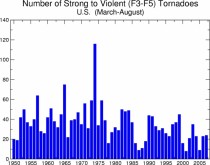
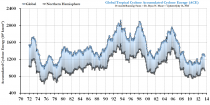
Roder, however, says that even if we adjust for population spread and increased property values, Munich Re still says there were significant increases in the costs of weather disasters over the past few years.
By Karen Kaplan, Los Angeles Times
The presidential candidates answer questions from ScienceDebate.org on technology, climate change and other science policy issues.
What is your position on cap-and-trade, carbon taxes and other policies proposed to address global climate change — and what steps can we take to improve our ability to tackle challenges like climate change that cross national boundaries?
Obama:
We have to meet this challenge by driving smart policies that lead to greater growth in clean-energy generation and result in a range of economic and social benefits. Since taking office I have established historic standards limiting greenhouse gas emissions from our vehicles for the first time in history. My administration has made unprecedented investments in clean energy, proposed the first-ever carbon pollution limits for new fossil-fuel-fired power plants and reduced carbon emissions within the federal government. We are also showing international leadership on climate change, reaching historic agreements to set emission limits in unison with all major developed and developing nations. I will continue efforts to reduce our dependence on oil and lower our greenhouse gas emissions while creating an economy built to last.
Romney:
I am not a scientist myself, but my best assessment of the data is that the world is getting warmer, that human activity contributes to that warming, and that policymakers should therefore consider the risk of negative consequences. However, there remains a lack of scientific consensus on the issue — on the extent of the warming, the extent of the human contribution and the severity of the risk — and I believe we must support continued debate and investigation within the scientific community.
The reality is that the problem is called global warming, not America warming. China long ago passed America as the leading emitter of greenhouse gases. Developed-world emissions have leveled off while developing-world emissions continue to grow rapidly, and developing nations have no interest in accepting economic constraints to change that dynamic. In this context, the primary effect of unilateral action by the U.S. to impose costs on its own emissions will be to shift industrial activity overseas to nations whose industrial processes are more emissions-intensive and less environmentally friendly. That result may make environmentalists feel better, but it will not better the environment.
So I oppose steps like a carbon tax or a cap-and-trade system that would handicap the American economy and drive manufacturing jobs away, all without actually addressing the underlying problem. I believe we should pursue what I call a “no regrets” policy — steps that will lead to lower emissions, but that will benefit America regardless of whether the risks of global warming materialize and regardless of whether other nations take effective action. For instance, I support robust government funding for research on efficient, low-emissions technologies that will maintain American leadership in emerging industries.
By Steve Goreham
On Sept. 20, the PBS News Hour did a segment titled “Arctic Icecap Shrinks to Record Low Level,"” with Ray Suarez interviewing Walt Meier of the National Snow and Ice Data Center. Ray leads off the segment: “The seasonal shrinkage in Arctic ice is more extensive than ever before....According to the National Snow and Ice Data Center, the low point came on Sunday, when ice covered just 24 percent of the Arctic Ocean. The previous low of 29 percent was set in 2007.” The substance of the PBS segment was correct but misleading for what it did not tell viewers.
PBS has long supported Climatism, the belief that man-made greenhouse gases are destroying Earth’s climate. PBS programming and website carry stories about melting icecaps, stronger hurricanes, flash floods, drought, wildfires, and even a poor cherry crop in Michigan, all assumed to be due to man-made emissions of carbon dioxide, a trace gas in our atmosphere.
To an objective observer who looks at the science, the theory of man-made global warming is incredible. Only four of every 10,000 air molecules are carbon dioxide and the amount that mankind could have added in all of human history is a fraction of only one of these molecules. Yet PBS and others claim that CO2 emissions are the source of our coming climate destruction.
During the interview, Ray Suarez pointed out that Arctic Ice was disappearing faster than climate models had predicted. Dr. Meier confirmed this, stating, “...we are seeing things go much faster than what the models had projected. The models had suggested that we may see a summer without - with very little ice by the end of this century.” This all sounds very alarming to the uninformed viewer.
But PBS and Dr. Meier have ignored the elephant in the room. The elephant is the Antarctic Icecap. While satellite data shows that Arctic ice has been declining for the last 30 years, the same satellite data shows that Antarctic ice has been expanding for 30 years.
It’s interesting that climate scientists are so alarmed by declining Arctic ice. The Arctic Icecap is only 1 to 2 percent of Earth’s ice, while the elephant, the Antarctic Icecap, contains about 90 percent of Earth’s ice. The climate models underestimated the decline in Arctic ice, but they are confounded by the growth in Antarctic ice. Data from Dr. Meier’s own National Snow and Ice Center shows that the extent of Antarctic sea ice for 2012 is greater than the 1979-2000 average. I wonder why he didn’t mention the good news about Antarctic ice on the PBS segment.
The Amundsen-Scott station is the current American scientific research station at the South Pole. For more than 50 years, the United States has maintained a continuous presence at the South Pole. The Amundsen-Scott station is the third U.S. station. The first two stations were buried by accumulating snow. Every year, the South Pole receives a net snow accumulation of about eight inches. The current station is modular and supported on stilts. It can be jacked up every year above the accumulating snow to prolong its life. Contrary to the fears of Climatism, 90 percent of Earth’s icecaps are expanding!
Steve Goreham is executive director of the Climate Science Coalition of America and author of the new book The Mad, Mad, Mad World of Climatism: Mankind and Climate Change Mania.
Paul Homewood
Other commentators have pointed out recently that, while Arctic ice is at record low levels since 1979, Antarctic sea ice levels are at or close to record highs. I thought, therefore, that this might be a good time to look at satellite temperatures for the two poles.
UAH monitor temperatures from 60N to 85N in the Arctic, and 60S to 85S in the Antarctic. While not complete, these records, of course, go much closer to the poles, and in a much more comprehensive fashion, than surface temperatures do.
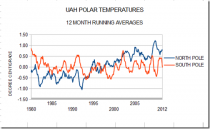
Figure 1
Figure 1 shows the UAH data, which is the anomaly from the 1981-2010 baseline, as a 12 month running average. This helps to smooth out the monthly and seasonal fluctuations and make the trend much clearer to see.
Two things stand out:-
1) Arctic temperatures were actually in decline during the 1980’s, before falling further around 1993, presumably as a result of the Pinatubo eruption two years earlier.
2) Between 1980 and 2012, Arctic temperature anomalies have increased from -0.22C to 0.79C, an increase of 1.01C. During the same period, however, Antarctic anomalies have fallen by 0.87C.
Of course, 1980 might not be a representative place to start. What we really need to look at are the trends leading up to that year. So what do the GISS records tell us for the period leading up to 1980?
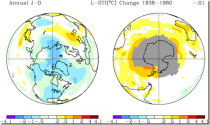
Figure 2
Although the Antarctic has a lot of missing data for 1938, (hence the grey), the temperature changes in the Arctic are quite clear, with most of the region about a degree colder in 1980 compared to 1938. So let’s combine the two periods.

Better still, we can look at the graph of GISS anomalies for the two poles between 1938 and 1980.
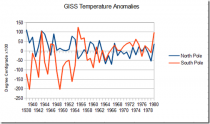
Enlarged
Conclusions?
1) Arctic temperatures are only slightly higher now than they were in the late 1930’s.
2) While temperatures have increased in the Arctic since 1980, there have been similar decreases in the Antarctic.
3) The biggest increases occurred in the Antarctic before 1980, although the amount of missing data there in the 1930’s and 1940’s must place a question mark over the accuracy of GISS data.
Warming records weren’t cooked
By Richard Chirgwin
Posted in Science, 9th September 2012 23:46 GMT
Free report: Optimising your hybrid data centre
A group of climate skeptics that includes Australian Dr Bob Carter has failed in its bid to have New Zealand’s High Court hear its complaint against that country’s National Institute of Water and Atmospheric Research (NIWA).
Dr Carter lined up with retired journalist Terry Dunleavy and computer modeler Bob Dedekind under the auspices of the New Zealand Climate Science Education Trust to accuse NIWA of fudging New Zealand’s climate record to present an alarmist picture of warming in New Zealand.
At issue was a data series first published in 1999 based on a series of seven weather stations (’7SS’![]() , showing a 1C warming trend in New Zealand over 100 years (which the Trust says is overstated), without applying a 1993 methodology developed by Rhoades and Salinger; that a later data set of eleven stations (11SS) was published in spite of what the Trust claimed were deficiencies in its data; and that the publication of 7SS “departed from recognized scientific opinion’.
, showing a 1C warming trend in New Zealand over 100 years (which the Trust says is overstated), without applying a 1993 methodology developed by Rhoades and Salinger; that a later data set of eleven stations (11SS) was published in spite of what the Trust claimed were deficiencies in its data; and that the publication of 7SS “departed from recognized scientific opinion’.
In this 186-paragraph decision, High Court judge Geoffrey Venning rejected all grounds for the Trust’s case, noting along the way that the High Court is not competent to rule on questions of science.
Justice Venning noted “This Court should not seek to determine or resolve scientific questions demanding the evaluation of contentious expert opinion.”
A court can, however, resolve questions of evidence, and here, the judge had some harsh words for the NZ Climate Science Education Trust’s witnesses. As a journalist, Dunleavy’s status as an expert witness was dealt with sharply: “Mr Dunleavy has, in any event, failed to comply with High Court Rule 9.43, and could not be regarded as an impartial expert”.
In a decision that has been seized on by bloggers such as Jo Nova, the judge also dismissed Dedekind’s evidence, stating that his “general expertise in basic statistical techniques does not extend to any particular specialised experience or qualifications in the specific field of applying statistical techniques in the field of climate science.”
Even Dr Carter’s evidence, as the sole expert witness admitted by the High Court, didn’t convince the judge. The Trust asked the court to find that NIWA had failed in its statutory duty, that its methodology was at fault, that it made errors of fact, and that publication of the climate data was unreasonable. The court dismissed all grounds for action
See Jon Stewart make fun of the party of inclusion.
The democratic campaign rolled out the red carpet this week for a former top Energy Department official who was at the center of the ill-fated government loan to Solyndra, a California solar panel firm that wound up in bankruptcy.
Steven J. Spinner joined other top fundraisers for a VIP tour of the Democratic National Convention floor in Charlotte Monday evening, posing and waving for a photographer while standing behind the podium. When he saw ABC News cameras, however, he ran for the exit.
WATCH World News with Diane Sawyer Tonight for More on Spinner and the DNC here
Spinner was last in the headlines in October, when emails surfaced showing he had pushed for the Solyndra loan from his post in the Energy Department, apparently in an effort to score the loan as a political victory for President Obama.
Brian Ross Interviews Big-Money Romney Backers Watch Video
“How hard is this? What is he waiting for?” Spinner wrote in one of them. “I have OVP [the Office of the Vice President] and WH [the White House] breathing down my neck on this.”
The fast-tracked Solyndra loan became the showpiece of the Obama administration’s Green Energy loan program—a plan to give a jolt of federal aid to firms developing new forms of alternative energy. Solyndra, the program’s inaugural loan recipient, received $535 million.
INTERACTIVE: Meet the 2012 Campaign Superdonors
But it fast became a symbol for Obama’s Republican opponents, who have characterized the loan as a boondoggle. The company’s bankruptcy led to a lengthy investigation by the Republican-led House Energy and Commerce Committee, which argued that the administration failed to heed warnings from budget analysts who believed the company was a bad bet.
White House officials have called the House investigation a waste of taxpayer money, noting that Republicans never uncovered any evidence to suggest the loan was granted as a result of political influence. week, Spinner has been attending a number of events organized for the campaign’s top donors—members of the National Finance Committee. He is sporting a badge that identifies him as a “Finance Guest.”
He appears also to be a top donor to the convention’s host committee, which accepts up to $100,000 from individuals to help offset the cost of the three-day Charlotte event. The host committee organized the podium tour that Spinner attended.
ABC News made repeated attempts to interview Spinner as the Solyndra saga unfolded, and he declined. When he was approached by ABC News on the convention floor Monday, he bolted for an exit.
A DNC employee blocked ABC News reporters from following Spinner as he broke into a run.
“You can’t follow people,” the aide said, as he held up his arms to keep the camera from filming Spinner as he left the venue.
Neither the Obama campaign nor the White House responded to requests for comment about Spinner.
This is not Spinner’s first foray into fundraising for Obama.
Spinner was awarded his high-ranking post with the Energy Department after raising more than $500,000 for Obama’s 2008 campaign, according to data compiled by the Center for Responsive Politics.
After taking the job, Spinner had to sign a waiver saying he would not get involved in deliberations involving Solyndra, because his wife’s law firm represented the company in certain legal matters. Press Secretary Jay Carney told reporters that Spinner “had no connection to overseeing the loan guarantee program."Spinner’s wife also pledged not to take proceeds from her firm’s work with companies that had applied for loans, and a spokesperson for Allison Spinner’s firm said she had not been involved in any Solyndra business.
But when the White House turned over internal emails to Congress, the records showed that Steve Spinner figured prominently into the Energy Department’s efforts to promote the loan politically. When the loan was set to be announced, he pushed for a “big event” with “golden shovels, bulldozers, hardhats, etc.,” according to one email he wrote.
--------
Elizabeth Warren will present herself and introduce Bill Clinton at the convention. Who is Elizabeth Warren - she is running against Senator Brown in Massachusetts. She has been a college law professor at Harvard. From 2010 to 2011, Elizabeth Warren was named by Barach Obama as special consultant in charge of implementing the Consumer Financial Protection Bureau. In 2011 however, Warren was removed from the running for director after Obama administration officials became convinced she “could not overcome strong Republican opposition.” She returned to Harvard.
Elizabeth Warren, who is a professor at Harvard with a specialty of policy work in bankruptcy and commercial law, has made high college tuition and burdensome student loans a centerpoint of her campaign for US Senate. She wants to be champion for the middle class.
Harvard has announced the 2012-2013 academic year term bill will be $54,496 -an increase of 3.5 percent, or $1,844, from $52,652 in the current year.
In percentage terms, this increase reflects a more moderate increase than that imposed during the recent past (a rise of $1,855, or 3.8 percent, from 2009-2010 to 2010-2011, and of $1,929, also 3.8 percent, in the subsequent year).
Inflation rate in 2010/11 averaged 2.4% and 2009/10 1.41%. This year the inflation rate is averaging 2.22%. So tuition increases continue to outpace inflation.
Back in 1990/91, the total fees were $20,655. Harvard today is 264% more expensive.
However, it seems instead of being a part of the solution, Warren is part of the problem. Warren earns $340,000 per year from Harvard for teaching a single course and gets a 0% interest home loan from the university as an incentive to relocate in the Boston area. I know many instructors and professors from other colleges in the northeast who earn a fraction of what professor Warren earns and teach multiple courses. It is the sweetheart deals like this that elitists professors are given that help push tuition out of the reach of all but the most affluent students.



